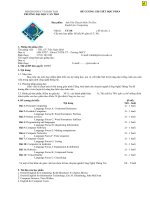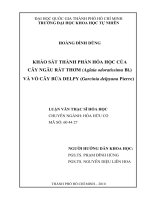Đề tài Anh Văn chuyên nghành hóa học
Bạn đang xem bản rút gọn của tài liệu. Xem và tải ngay bản đầy đủ của tài liệu tại đây (239.67 KB, 32 trang )
Science Lab
Equipment
Identification
Lab
Florence Flask
A Florence flask (also known as a
round bottom flask or a boiling flask)
is a piece of laboratory glassware. It
is a round or flat-bottom flask with a
long neck. It is designed for uniform
heating and is produced in a number
of different glass thicknesses to stand
different types of use. They are often
made of borosilicate glass that has
alkali to prevent cracks or defacing of
the glass. The flask is named after
Florence, Italy.
Ring, Ring Stand, & Clamp
Erlenmeyer Flask
•
An Erlenmeyer flask (also known as a conical
flask) is a type of laboratory glassware which
consists of an inverted conical base with a
cylindrical neck. The main advantages in an
Erlenmeyer flask are that it is less likely to tip
over than a Florence flask and the smaller neck
slows evaporative loss better than a beaker. It
can also be swirled without fear of the contents
spilling. It is named after the German chemist
Richard Erlenmeyer. The conical flask's
counterpart is the beaker. However the main
difference is that conical flasks may be
stoppered using rubber bungs, so as the
contents of the flask may be mixed or
transported safely. The flask is not usually used
when heating substances vigorously, this task
usually being left to the Florence flask.
Stopper
•
A stopper is a truncated conical
piece of rubber or cork used to close
off a glass tube, piece of
laboratory glassware, a wine bottle or
barrel and other containers with
orifices. A rubber stopper is
sometimes called a rubber bung,
and a cork stopper is called cork.
Ground glass stoppers are commonly
used with laboratory glassware,
mainly because of their nonreactivity.
Beaker
•
A beaker is a type of laboratory glassware which
consists of a cylindrical cup with a notch on the
top to allow for the pouring of liquids. They are
about as wide as they are tall. This makes
beakers very stable and easy to handle. They
may be made of plastic, glass, or Pyrex®. Some
beakers have graduated markings, or
calibrations, to allow an easy rough measure of
liquid volume. As a means to make solutions,
they are probably the most used piece of
laboratory glassware. Coupled with a good
magnetic stirrer, they see frequent heavy use in
a laboratory. Like a test tube or a boiling tube, a
beaker can be placed over a burning flame (such
as a Bunsen burner) to be heated.
Test Tube
•
A test tube (Sometimes culture tube) is a kind
of laboratory glassware, composed of a
fingerlike length of glass tubing, open at the top,
sometimes with a rounded lip at the top, and a
rounded 'U' shaped bottom. They range in size
from a few centimetres to over 20 centimetres in
length and from a few millimetres to several
centimetres in diameter. They are designed to
allow easy heating of samples, to be held in a
flame, and often are made of expansion-
resistant glasses, such as Pyrex. Tests tubes
are often preferred above beakers when multiple
small chemical or biological samples have to be
handled and/or stored.
Test Tube Rack
Used to store and hold test tubes in an upright
position.
Test Tube Holder
Used to hold test tubes, especially when heated or
containing harmful chemicals.
Test Tube Brush
Used to clean the insides of test tubes.
Graduated Cylinder
•
A graduated (Grad for short) cylinder, also
referred to as a measuring cylinder, is a type of
laboratory glassware that is used for measuring
the volumes of liquids in a quantitative manner.
The top usually has a small curled lip to allow
easy pouring of liquids, and the bottom is usually
anchored with a wide base, to keep the cylinder
from easily tipping. The volumes of liquids
graduated cylinders can handle range from a few
milliliters to many liters. A graduated cylinder can
be made of plastic or glass or Pyrex. Often, the
largest graduated cylinders are made of plastic,
making them lighter and more break resistant.
Petri Dish
•
A Petri dish is a shallow glass or plastic
cylindrical dish that biologists use to culture
microbes. It was named after the German
bacteriologist Julius Richard Petri (1852-1921)
who invented it in 1877 when working as an
assistant to Robert Koch. Usually, the dish is
partially filled with warm liquid agar along with
a particular mix of nutrients, salts and
amino acids and, optionally, antibiotics, that
match the metabolic needs of the microbe
being studied (technically referred to as a "
selective medium"). After the agar solidifies,
the dish is ready to receive a microbe-laden
sample (although to grow some microbes it is
often necessary to apply the sample with the
hot agar). Modern Petri dishes often have rings
on the lids and bases which allow them to be
stacked so that they do not slide off of one
another. As well as making agar plates, empty
Petri dishes may be used to observe plant
germination, or small animal behaviour.
Culture Dish
Mortar and Pestle
•
A mortar and pestle are two tools used with
each other to grind and mix substances. The
mortar is a bowl-like vessel used to contain a
substance. Mortars have smooth, rounded
bottoms and wide mouths. The pestle is a stick
used for pounding and grinding. Mortar and
pestles were traditionally used in pharmacies to
crush various ingredients prior to preparing an
extemporaneous prescription. The mortar and
pestle is the most common icon associated with
pharmacies. For pharmaceutical use, the mortar
and the head of the pestle are usually made of
porcelain, while the handle of the pestle is made
of wood.
Funnel
•
A funnel is a conically shaped pipe, employed
as a device to channel liquid or fine-grained
substances into containers with a small
opening. The diameter of the spout of a
regular kitchen funnel is about 1 /10 that of the
upper bowl. The almost cylindrical tube below
the conical upper part that opens into the
spout can vary in length. Funnels are usually
made of either stainless sheet metal or plastic,
but sometimes paper funnels are used in
cases where it would be difficult to adequately
clean the funnel afterwards (for example, in
adding motor oil to a car).
Eye Dropper/Medicine Dropper
Used to mix or dispense small amounts of liquid, a
drop at a time.
Microscope
A microscope (Greek: micron =
small and scopos = aim) is an
instrument for viewing objects
that are too small to be seen by
the naked or unaided eye.
Microscope Slide & Cover Slip
•
A microscope slide is a thin sheet of glass
used to hold objects for examination under a
microscope. A standard microscope slide
(shown on the right) is 75 x 25 mm (3" X 1")
and 1.2 mm thick. A range of other sizes is
available for various special purposes. Since
compound or high power microscopes have
a very narrow region within which they focus,
the object to be viewed ("specimen") is
typically placed on the middle of the slide
with another, much thinner square (or circle
or rectangle) of glass placed over the
specimen. This smaller sheet of glass is
called a cover slip or cover glass, and
typically measures between 18 and 25 mm
on a side. The cover glass serves two
purposes: (1) it protects the microscope's
objective lens from contacting the specimen,
and (2) it creates an even thickness (in wet
mounts) for viewing.
Hand Lens/Magnifying Glass
•
A magnifying glass is a single convex lens
which is used to produce a magnified image
of an object. The lens is usually mounted in
a frame with a handle. The magnifying
glass is the simplest form of
optical microscope. A magnifying glass
works by creating a magnified virtual image
of an object behind the lens. The distance
between the lens and the object must be
shorter than the focal length of the lens for
this to occur. A lens is a device for either
concentrating or diverging light, usually
formed from a piece of shaped glass.
Telescope
The word "telescope" (from the Greek tele = 'far'
and skopein = 'to look or see'; teleskopos = 'far-
seeing') usually refers to optical telescopes, but
there are telescopes for most of the spectrum of
electromagnetic radiation and for other signal
types.
An optical telescope is an optical tool that gathers
and focuses electromagnetic radiation.
Telescopes increase the apparent angular size of
distant objects, as well as their apparent
brightness. Telescopes work by employing one or
more curved optical elements - lenses or mirrors -
to gather light or other electromagnetic radiation
and bring that light or radiation to a focus, where
the image can be observed, photographed or
studied.
Triple Beam Balance
•
A balance (also balance scale, beam balance or
laboratory balance) is used to accurately measure the
mass of an object. This class of measuring instrument
uses a comparison technique in its conventional form of
a beam from which a weighing pan (weighing bason)
and scale pan (scale bason) are suspended. To weigh
an object, it is placed on the measuring pan, and
standard weights are added to the scale pan until the
beam is in equilibrium.
Tongs
•
Tongs are gripping and lifting tools, of which
there are many forms adapted to their specific
use.
Safety Goggles
•
Goggles or safety glasses are
a form of protective eyewear that
usually enclose the eye area to
prevent particulates or chemicals
from striking the eyes. They are
used in chemistry laboratories
and in woodworking
Thermometer
•
A thermometer is a device
used to measure
temperatures or
temperature changes.
Hot Plate
•
A hot plate is a small electric stove
often used in a laboratory setting to
heat glassware. Some hotplates
also contain a magnetic stirrer,
allowing the heated liquid to be
stirred simultaneously. Hot plates
are also used in food preparation,
generally for small dishes in places
where a full kitchen stove would
not be convenient.









